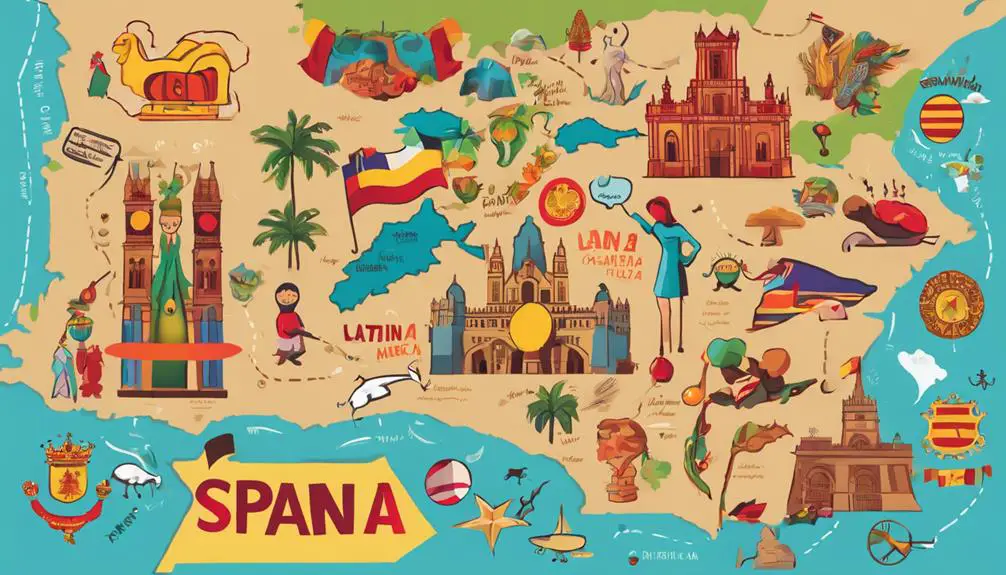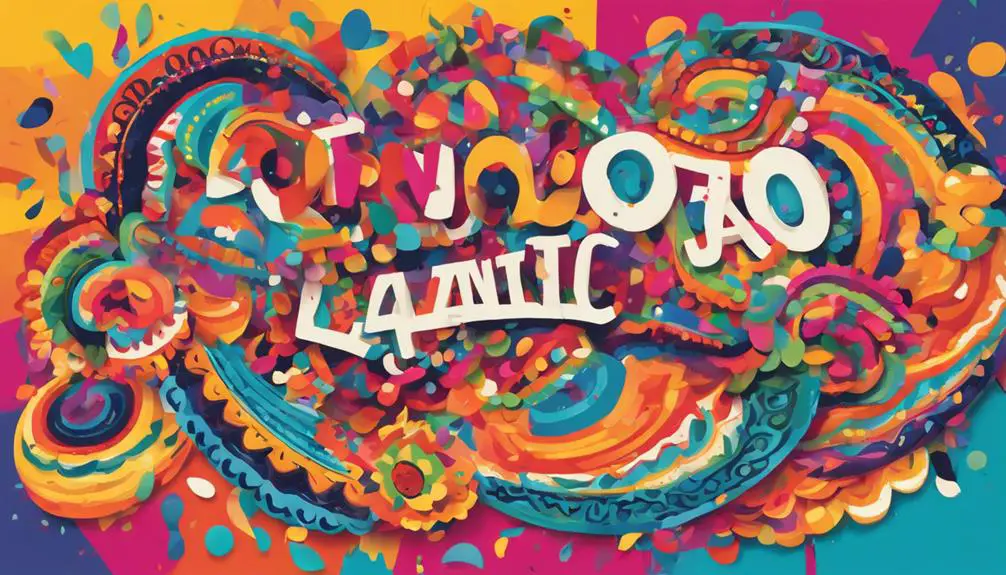When it comes to speaking Spanish, you'll want to immerse yourself in slang to sound like a native. But first, know that slang varies across regions, like Madrid and Mexico City, and is shaped by cultural and historical factors. Start by mastering common slang words and phrases, like 'guay' and 'chulo', which have historical roots. Then, explore regional differences, like Lunfardo in Argentina, to deepen your connection with locals. Finally, practice using slang in everyday conversations, adjusting your tone and language based on context and cultural nuances. Engage with media sources like telenovelas and music to improve your skills – and there's more to discover.
Understanding Regional Slang Differences

When you explore Spanish slang, you'll quickly realize that what's cool in Madrid mightn't be cool in Mexico City, and that's because regional slang differences are a thing. You can't assume that what's trendy in one Spanish-speaking country or region will be understood or even relevant in another. Regional dialects play a significant role in shaping the slang landscape.
For instance, in Spain, 'guay' is a common slang term for 'cool,' whereas in Mexico, it's more common to say 'chido' or 'padre.'
Slang evolution is also influenced by cultural and historical factors, such as immigration, colonization, and urbanization. As people move and interact, they bring their language patterns with them, contributing to the rich diversity of Spanish slang.
Understanding these regional differences is important to communicating effectively and avoiding cultural faux pas. By acknowledging and embracing these variations, you'll be better equipped to navigate the complex world of Spanish slang like a native.
Most Common Spanish Slang Words
Your Spanish slang journey starts with mastering the most commonly used words and phrases that'll help you sound like a local. You'll want to focus on words that have been adopted into everyday language, often originating from informal settings like streets, markets, or social gatherings.
These slang words have evolved over time, influenced by cultural and social factors. For instance, the word 'guay' (cool) originated in the 1980s and has since become a staple in Spanish slang. Similarly, 'chulo' (cool or stylish) has its roots in the 17th century, initially used to describe something elegant or refined.
As you explore the world of Spanish slang, you'll notice how words have adapted to reflect changing attitudes and values. You might come across 'pijo' (preppy or posh), which emerged in the 1990s to describe a certain socioeconomic group.
Slang in Latin American Countries

As you venture into the diverse world of Latin American slang, you'll discover that each country has its unique flavor of expressions, shaped by local culture, history, and geography.
You'll find that slang in Latin America is a reflection of the region's cultural evolution, with each country's language influenced by its indigenous, African, and European roots.
When exploring slang in Latin American countries, it's essential to acknowledge the country-specific nuances that set each region apart.
For instance, in Mexico, you'll encounter phrases like '¡Mande?' (what did you say?) or 'Simón' (okay), while in Colombia, you'll hear 'Parce' (friend) or 'Rumbear' (to party).
Understanding these regional differences will help you better connect with locals and avoid cultural missteps.
By embracing the diversity of Latin American slang, you'll gain a deeper appreciation for the region's rich cultural heritage.
Mastering Argentinian Lunfardo Slang
Exploring the vibrant streets of Buenos Aires, you'll discover that Lunfardo slang is an integral part of Argentinian culture. This unique dialect originated in the late 19th century, influenced by European immigrants, particularly Italians, who arrived in Argentina. They brought with them their languages, which eventually merged with Spanish to create Lunfardo.
As you investigate the city, you'll notice that Lunfardo is deeply rooted in the Tango culture, with many Tango lyrics featuring Lunfardo phrases. The Tango influence is undeniable, with Lunfardo words and phrases often used to describe the passionate and sensual dance. For instance, 'mina' (girl) and 'pibe' (guy) are commonly used in Tango lyrics and everyday conversations. Mastering Lunfardo slang will give you a deeper understanding of Argentinian culture and allow you to connect with the locals on a more authentic level.
As you explore further into the world of Lunfardo, you'll uncover a rich cultural heritage that's waiting to be explored. So, take the first step, and immerse yourself in the vibrant world of Lunfardo slang.
Everyday Conversations With Slang

When chatting with locals, you'll quickly realize that incorporating slang into everyday conversations is key to sounding like a true porteño. Using casual expressions like 'ché' (dude) or 'boludo' (buddy) will make you sound more relatable and friendly. It's not just about throwing in a few trendy phrases, though – it's about embracing a slang identity that's authentic and natural.
In everyday conversations, you might hear '¿Cómo vas?' (how are you?) or '¿Qué onda?' (what's up?). These casual expressions are woven into the fabric of daily interactions, and using them will help you blend in.
You might even pick up on regional slang, like 'chau' (goodbye) in Argentina or 'harto' (tired) in Chile.
Using Slang in Different Contexts
You'll find that using slang in different contexts can greatly impact the tone and reception of your message, whether you're chatting with friends at a Buenos Aires asado or negotiating a deal with a Chilean business partner.
Mastering slang etiquette is essential to avoid misunderstandings and unintended offense. In formal settings, like business meetings or professional emails, it's best to stick to formal language to convey respect and professionalism. However, in casual gatherings or online forums, using slang can help you fit in and build rapport with locals.
When deciding which slang to use, consider the cultural nuances of the region and audience. For instance, Argentine slang is often more playful and expressive, while Chilean slang is known for being more subtle and dry. Be mindful of regional differences and adjust your slang accordingly.
Practice With Slang in Media Sources

How can you improve your slang skills without actually living in a Spanish-speaking country? One way is to immerse yourself in media sources that showcase authentic language use. Watching telenovelas, or Spanish-language soap operas, is an excellent way to pick up on colloquial expressions and slang. You'll get to see how characters interact with each other, using informal language that's relatable and engaging.
Pay attention to how they greet each other, argue, or make jokes – it's all about context. You can even rewind or pause to catch phrases you didn't understand.
Another great resource is music. Reading lyrics from popular Latin American artists can expose you to regional slang and idioms. You might come across words or phrases you've never heard before, but that's the beauty of it – you'll learn something new!
Look up lyrics from genres like reggaeton, bachata, or Latin pop to get a feel for the rhythm and flow of slang in Spanish. By incorporating these media sources into your language practice, you'll be well on your way to sounding like a native Spanish speaker.
Frequently Asked Questions
Can I Use Spanish Slang in Formal Writing or Professional Settings?
You're wondering if you can pepper your formal writing or professional settings with Spanish slang. The short answer is: probably not. In formal writing, you want to maintain a professional tone, and slang can come across as too casual.
Stick to a formal tone and professional etiquette, even if you're writing in Spanish. Save the slang for casual conversations with friends or online forums where it's more acceptable.
How Do I Know Which Slang Words Are Appropriate for My Age Group?
You're like a chef trying to whip up a dish that's both authentic and appealing to your age group.
When it comes to using slang, you want to avoid being that person who's trying too hard to be cool.
To navigate age-specific slang norms, think about your age identity and the cultural references that resonate with your peers.
Research what's currently trending and what's considered outdated or cringeworthy.
Blend in by using slang that's relatable and respectful, without overdoing it.
Are There Any Spanish Slang Words That Are Universally Understood?
You're wondering if there are Spanish slang words that everyone gets, regardless of where they're from.
The good news is, yes, there are some universally understood terms that transcend regional dialects. Many Latin American countries share a global dialect rooted in Latin roots.
Words like 'guay' (cool) or 'chido' (awesome) are widely recognized. You'll find that these words are often used in music, movies, and social media, making them familiar across different cultures and age groups.
Can I Create My Own Spanish Slang Words and Phrases?
You're wondering if you can create your own Spanish slang words and phrases? Absolutely, you can! In fact, that's what cultural fusion is all about – blending your personal identity with the language.
Go ahead, get creative, and invent your own slang! Just remember, the key to making it stick is to use it consistently and share it with others.
Who knows, your phrase might just become the next big thing in Spanish slang!
Is It Necessary to Learn Regional Slang to Communicate Effectively?
You're probably wondering if learning regional slang is necessary to communicate effectively.
Did you know that 70% of language learners believe that speaking like a native is essential for effective communication?
To achieve language authenticity, cultural immersion is key.
While it's not necessary to learn every regional slang, understanding local expressions will help you connect with native speakers on a deeper level.
Focus on the regions that matter most to you, and you'll be well on your way to communicating effectively and authentically.
Conclusion
You've mastered the art of speaking Spanish slang! You've explored the ins and outs of regional differences, learned the most common words, and even delved into the unique world of Argentinian Lunfardo.
Now, you're ready to take your conversations to the next level. But remember, slang is like a spice – a little goes a long way. Use it to add flavor to your conversations, but don't overdo it.
With practice and patience, you'll be speaking like a native in no time, effortlessly switching between formal and informal contexts.
¡Buena suerte!







